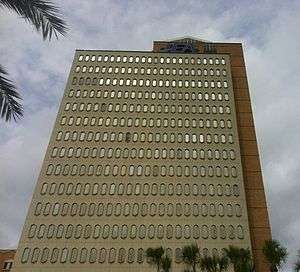JEA
|
| |
 Headquarters in the Northbank area of Downtown Jacksonville | |
| Public-benefit | |
| Industry | Public Utility |
| Predecessor | City of Jacksonville Electric Department |
| Founded | 1968 |
| Headquarters |
Jacksonville, Florida USA |
Key people |
Paul McElroy, CEO & Managing Director James M. Chansler, COO[1] |
| Products |
Electric utility Drinking water Sewage treatment Chilled water Reclaimed water |
| Total assets | $7.5 billion (2010) |
| Total equity | $1.5 billion (2010) |
Number of employees | 2,000 approximate (2010) |
| Slogan | "Building Community" |
| Website | www.jea.com |
JEA (Jacksonville Electric Authority), located in Jacksonville, Florida, is the eighth largest community-owned electric utility company in the United States and largest in Florida. As of 2009, JEA serves more than 417,000 electric customers, 305,000 water customers and 230,000 sewer customers. Besides Jacksonville (Duval County), JEA also has customers in Clay, Nassau and St. Johns counties.
History
Jacksonville's water and sewer systems had been operated by the city since 1880, and an electric system since 1895. The electric system grew with the city, but remained a department of city government until an independent authority was created by the consolidation of city and county governments in 1968.
According to Article 21 of the Jacksonville City Charter,
"JEA is authorized to own, manage and operate a utilities system within and outside the City of Jacksonville. JEA is created for the express purpose of acquiring, constructing, operating, financing and otherwise have plenary authority with respect to electric, water, sewer, natural gas and such other utility systems as may be under its control now or in the future."[2]
During the 1970s, JEA's electric rates were among the highest in the nation. There were reports of customers with electric bills higher than their mortgage payments.
Royce Lyles became JEA Managing Director on September 1, 1979 and the utility began diversifying its fuel mix. Rates began to drop, eventually becoming the lowest in the state and near the bottom in the Southeast.
Walt Bussells was appointed Managing Director on September 8, 1995, following Royce Lyles' retirement.
On June 1, 1997, Jacksonville's Department of Public Utilities, water and sewer operations merged into the Jacksonville Electric Authority.
Bussells embraced new technology and in 2002, JEA introduced online bill payment and implemented network meter reading. In 2003, the utility also began providing Chilled water for air conditioning in downtown buildings. The first two customers were the downtown library and the John Milton Bryan Simpson United States Courthouse. When the new Duval County Courthouse opens in 2012, it will use chilled water. Purchasing chilled water eliminates the need for chillers and cooling towers at each property, reducing capital outlays and eliminating ongoing maintenance costs. The space saved can also become rentable, increasing revenue.[3]
Under Bussells, Jacksonville's electric rates had remained artificially low throughout the 1990s and into the 2000s, despite large expenditures following the water/sewer acquisition in 1997, technology improvements and construction of chilled water equipment. These projects were financed with borrowed money.
Jim Dickenson replaced Walt Bussells when Bussells retired on June 15, 2004 after nine years as CEO.[4] Soon after taking over, Dickenson implemented the first of three temporary fuel rate increases to offset rising fuel costs.
On September 7, 2012 JEA Board of Directors named Paul McElroy to fill the role of JEA Chief Executive Officer and Managing Director effective October 1, 2012.[5]
The utility's debt was $6.0 billion, against assets of $7.5 billion. Compared to other similar sized municipal utilities, JEA had 60% more debt per customer, which could lower the utility's bond rating and make it more expensive and difficult to borrow money.[6]
In 2007, JEA had the second-lowest electric rates in Florida before they announced a four-year base rate increase package that would raise the average bill from $112 to more than $140 in 2010.[7] The additional revenue was designed to reduce debt.
In early 2012, Dickenson announced that he would retire February 1, 2013.[8]
Services
- Electricity: owns/operates three generating plants and all transmission and distribution facilities; co-owns two additional power plants with Florida Power & Light: the St. Johns River Power Park in northeastern Jacksonville; and Unit 4 of Plant Scherer, near Macon, Georgia. JEA also operates a methane-fueled generating facility at the Girvin Road Landfill.
- Water: 134 artesian wells tapping the Floridan Aquifer are distributed through 35 water treatment plants and 4,208 miles (6,772 km) of water lines.
- Sewer: 3,760 miles (6,050 km) of collection lines and seven regional and eight non-regional sewage treatment plants.
- Chilled water: the company owns one chiller plant in downtown Jacksonville which provides the commodity to nearby facilities to heat and cool their buildings' air and equipment.
See also
- JEA Northside Generating Station
- Plant Scherer (owned in part by JEA)
- List of power stations in Florida
References
- ↑ Hoovers.com: company factsheet-JEA
- ↑ "Article 21. -JEA" Municode website, Jacksonville City Charter
- ↑ Jacksonville Business Journal: July 11, 2003-JEA's cool idea can save by Chuck Day
- ↑ Hunt, David: "There's more behind a man than CEO: JEA's Jim Dickenson" Florida Times-Union, April 29, 2010
- ↑ JEA Board of Directors Names McElroy New CEO jea.com
- ↑ Fitch Rates JEA/St. Johns River Power Park
- ↑ Florida Times Union article
- ↑ Palka, Mary Kelli: "JEA chief executive Jim Dickenson says he will retire next year" Florida Times-Union, January 17, 2012